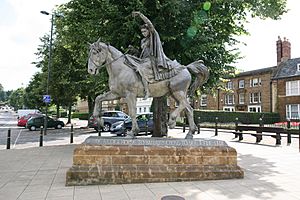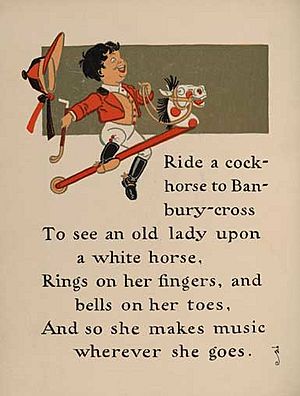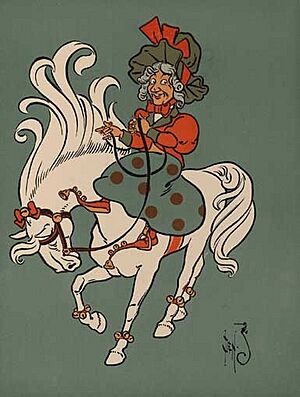Ride a cock horse to Banbury Cross facts for kids
Quick facts for kids "Ride a cock horse to Banbury Cross" |
|
|---|---|

The statue of the "fine lady" at Banbury Cross
|
|
| Nursery rhyme | |
| Published | 1784 |
"Ride a cock horse to Banbury Cross" is a well-known English language nursery rhyme. It is connected to the town of Banbury in Oxfordshire, England. The rhyme has been popular for a very long time.
Contents
What the Rhyme Says

The most common words for this rhyme today are:
Ride a cock-horse to Banbury Cross,
To see a fine lady upon a white horse;
Rings on her fingers and bells on her toes,
And she shall have music wherever she goes.
A "cock-horse" is like a toy horse or a stick that children pretend to ride. Banbury Cross is a famous monument in the town of Banbury.
Another Version of the Rhyme
There is also another version of the rhyme that you might hear:
Ride a cock-horse to Banbury Cross,
To buy little Johnny a galloping horse;
It trots behind and it ambles before,
And Johnny shall ride till he can ride no more.
Where the Rhyme Came From
The rhyme "Ride a cock-horse to Banbury Cross" has been around for many years. It is the most famous of several rhymes that start with the same line. Some of these older versions were written down even earlier.
Early Rhyme Books
One of the first times a similar rhyme appeared was in a book called Tommy Thumb's Pretty Song Book. This book was printed around 1744. The words in that early version were a bit different:
Ride a cock-horse
To Banbury Cross,
To see what Tommy can buy;
A penny white loaf,
A penny white cake,
And a two-penny apple-pie.
This shows that the rhyme was originally about buying things at Banbury Cross.
Changes Over Time
The version of the rhyme we know best today first appeared in a book called Gammer Gurton's Garland in 1784. In this very early version, the rhyme was not about a "fine lady." Instead, it talked about "an old woman."
Later, in a book from America in 1788, the "fine lady" version appeared. However, another book printed around 1790, The Tom Tit's Song Book, still talked about an "old woman" but added details about her clothes:
A ring on her finger,
A bonnet of straw,
The strangest old woman
That ever you saw.
Over time, the rhyme changed and developed into the popular version we sing today, focusing on the "fine lady" with rings and bells.


